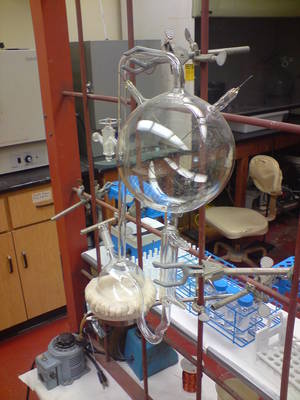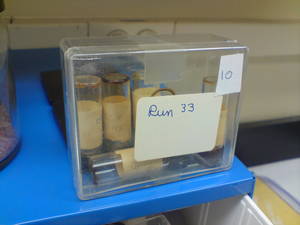Getting Life Started on Earth
Interview with
One of the most fundamental questions about how life began in the first place must be answered here on Earth. In the 1950s, the chemist Stanley Miller made history when he recreated some of the conditions of the early Earth in a complicated glass apparatus in which he mixed water, ammonia, methane and hydrogen. He heated it and then he zapped it to simulate lightning, and from those simple experiments one of the building blocks of life emerged, the amino acid glycine. Recently, Jeffrey Bada who's a Professor of Marine Chemistry at the University of California, San Diego - and a former student of Stanley Miller - rediscovered the samples from Miller's original experiments in his lab, and he has since spent quite a bit of time re-analysing them using modern chemical techniques that weren't available to Stanley Miller when he first did those experiments. Chris Smith heard from Jeff what he found when he reanalysed the original samples from Miller's experiments...
Jeff - We found a lot more amino acids, of course, using modern analytical methods. What was interesting was that some of those amino acids look very similar to the kinds of amino acids that we see present in carbonaceous chondrites, a type of meteorite. So, I think this was a nice demonstration that this early experiment had mimicked chemistry not only possible on the early Earth, but elsewhere in the solar system.
 Chris - Just talk us through exactly what Stanley Miller did and why it's so useful as an indicator of what could have been going on when the planet was much younger.
Chris - Just talk us through exactly what Stanley Miller did and why it's so useful as an indicator of what could have been going on when the planet was much younger.
Jeff - Well, the idea was to simulate some sort of early Earth environment. One that Stanley Miller and Harold Urey came up with was a glass apparatus that simulated the ocean/atmosphere interaction. And so, there was a flask that contained water which would represent the ocean, that was connected to a larger flask where there were electrodes that could simulate lightning in the form of a spark discharge. And then from the gas flask, there was a tube running back into the water flask. So this was a cycle where you evaporate water from the ocean, that interacts with gases in the atmosphere which were subjected to a spark discharge or lightning bolt, and then this washes out of the atmosphere back into the water. And so, this was not an ad hoc design. It was a very carefully thought out design. What's interesting is that Miller studied three different apparatus configurations. The one I just described is what we call the 'classical apparatus' because it's the one you see in textbooks. But there was another apparatus that was interesting to us, and that was one in which the water flask was connected directly to the gas flask by a little aspirator, a little tiny tube in which water, when it boiled out of the water flask, was injected into the spark gas flask in the form of a jet of steam, much like a geyser that happens on the Earth today.
Chris - Or a volcano, presumably.
Jeff - Or a volcano, yes. And so, we were very interested in this because Stanley only published one brief communication on that apparatus, and it strongly suggested that the yields were better than in his classical apparatus, but he never followed through with it for whatever reason. So, when we found all these archived extracts from his original experiments, we were stunned to find all of the ones preserved from not only his classical apparatus, but also from the volcanic apparatus and another configuration. And we were particularly interested in that volcanic apparatus because, like I said, based on his preliminary results, we thought the yields might be higher and so, when we analysed that, lo and behold! We found a lot more different amino acids, ones that had never been made before. In addition, the composition of those amino acids looked even more strikingly similar to what we saw in meteorites. And so, I believe this really is a nice example of how you could have localised systems on the early Earth, consisting of small volcanic systems, where you did a lot of synthesis which before people thought happened in a sort of a global atmosphere.
Chris - It's Darwin's warm little pond almost, isn't it? So, you're saying that what they show is that even with very, very simple setups, you can produce really quite complicated molecules which are some of the fundamental building blocks of life systems. And so, it's perfectly possible for Earth, from very, very basic building blocks, to assemble some really complicated molecules that we would have needed?
Jeff - That's correct, yes. And the more we get into this, the more compelling that argument - that experiment is today. One of the other things we found was that there were a set of experiments that he did in 1958, in which he isolated these various extracts from the experiment and he carefully catalogued them, set them aside, and put them in these little boxes and then he never analysed them or never reported on them. They're carefully recorded in his notebook, but he never followed through with the final analyses. One in particular caught our attention because it was the first experiment of this type that used the gas hydrogen sulphide, H2S, which smells like rotten eggs. When we analysed that set of samples, we found an even a larger array of amino acids. So you put all these together, both the volcanic, coupled with the H2S experiment; he made on the order of 50 different amino acids which is remarkable, given the simplicity of the experiment.
Chris - And what's the relevance to finding this in the chondrites, the meteor samples? Why is that important?
 Jeff - Well, I think there's been a controversy about whether the atmosphere of the early Earth ever had the composition that Miller used in his original experiments and so, I've heard comments that the pre-biotic soup is irrelevant, that the Miller experiment is irrelevant. Well, the finding, that we found strikingly similar compositions in this spark discharge experiment compared to the carbonaceous meteorites, indicates that this type of synthesis took place somewhere in the solar system. So, the Miller experiment, even though you argue it may not be relevant to the Earth - which I strongly disagree with - certainly took place some place in the solar system. My own thinking is that in the early solar nebula, you made bioelectric discharges. We know that there is intense lightning in solar nebula that produce the reagents you need for amino acid synthesis - aldehydes, ketones, hydrogen cyanide - and those coalesced into the meteorite parent body. And during the time that the meteorite parent body where water percolated to the meteorite, you made the amino acids. So, it's very analogous to what he did in these experiments, but it happened some place in the solar system.
Jeff - Well, I think there's been a controversy about whether the atmosphere of the early Earth ever had the composition that Miller used in his original experiments and so, I've heard comments that the pre-biotic soup is irrelevant, that the Miller experiment is irrelevant. Well, the finding, that we found strikingly similar compositions in this spark discharge experiment compared to the carbonaceous meteorites, indicates that this type of synthesis took place somewhere in the solar system. So, the Miller experiment, even though you argue it may not be relevant to the Earth - which I strongly disagree with - certainly took place some place in the solar system. My own thinking is that in the early solar nebula, you made bioelectric discharges. We know that there is intense lightning in solar nebula that produce the reagents you need for amino acid synthesis - aldehydes, ketones, hydrogen cyanide - and those coalesced into the meteorite parent body. And during the time that the meteorite parent body where water percolated to the meteorite, you made the amino acids. So, it's very analogous to what he did in these experiments, but it happened some place in the solar system.
Chris - Would the idea then be that it's not just potentially Earth that is making these biological building blocks? It could also be that our entire solar system made them. They happen to land on Earth as much as anywhere else and Earth was the right place for life to then get spawned?
Jeff - I think that's probably true, yes. You had both home grown synthesis directly on the Earth and stuff falling in from space which all contributed to this primordial soup that led eventually to more complex molecules that eventually spawned the first self-replicating entities which was the origin of life.










Comments
Add a comment